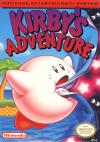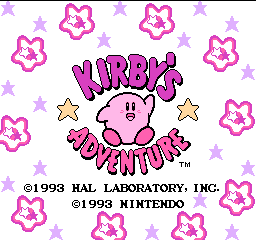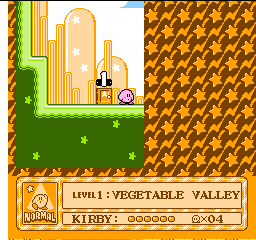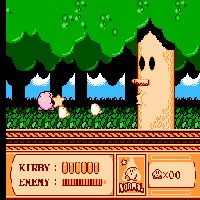Forum Links
Thread Information
Views
730
Replies
0
Rating
0
Status
OPEN
Thread
Creator
Creator
pollution_skunk
12-31-13 04:44 PM
12-31-13 04:44 PM
Last
Post
Post
pollution_skunk
12-31-13 04:44 PM
12-31-13 04:44 PM
System
9.2
Views: 373
Today: 0
Users: 2 unique
Today: 0
Users: 2 unique
Thread Actions
Order
The true kickstarter of the Kirby franchise
Game's Ratings
Overall
Graphics
Sound
Addictiveness
Depth
Story
Difficulty
Average User Score
9.2
8.6
8.6
8.1
7.9
7.1
4.9
12-31-13 04:44 PM
pollution_skunk is Offline
| ID: 948720 | 1829 Words
| ID: 948720 | 1829 Words
Level: 26




POSTS: 23/130
POST EXP: 41665
LVL EXP: 100642
CP: 2575.4
VIZ: 23321
POSTS: 23/130
POST EXP: 41665
LVL EXP: 100642
CP: 2575.4
VIZ: 23321

Likes: 0 Dislikes: 0
As I said before in my Recca review, the NES' last years (1989-1994) were an amazing time for the console and it's owners. The ugly grey toaster that somehow saved the then-young videogame industry from the Great Crash of 1983 was pretty old at the time, but Nintendo enginereed it so that it could live forever in the minds of videogamers and developers alike! When such achievment is successfully obtained in the virtual entertainment industry (which it was in the NES' case), it's common for dedicated developers to keep making software for it even when better equipment exists out there, and this (seemingly) insane dedication often leads into dev teams "mastering" the hardware they work on - i.e., being able to squeeze every single bit of processing power the console/handheld has to offer. One of those teams that managed to do so with the NES was Nintendo themselves... Well, not exactly. I'm actually talking about HAL Laboratory (ex-HALken), the Big N second-party/subdivision responsible for Kirby, Super Smash Brothers, EarthBound (partially) and many other classic franchises exclusive to the japanese developer's devices. What few people know is that before being directly combined with Big N in the late 90's/early 00's, HAL was a developer free to work in any hardware they wished to! In fact, their first creation was the Eggerland/Adventures Of Lolo series of cutesy-but-though-with-a-few-quirks sliding-puzzle games, with the first in the series, the eponymous Eggerland Mystery! (yes, it has that exclamation mark at the end), being released in Japan and Europe for MSX1 computers in 1985, three years before they struck a deal with Nintendo. After re-creating and remixing the previously-released Eggerland games for Nintendo's 80's console, their first "original" creation for the nipponic gargantuar was a tech demo showcasing the then-upcoming Game Boy's capabilities. The project presented was a simple platformer with a smiley face nicknamed "PoPoPo" as the player's (in this case, a young Masahiro Sakurai) avatar. Liking the character and the concepts presented in the demonstration, He, the great Shigeru Myiamoto, demanded that it had to be made into a full game with his assistance. PoPoPo was developed into a round hyperactive little... thing... with arms and feet and a voracious appetite, and thus Kirby's Dreamland was born. It was a massive hit (as all Nintendo games were at the time), spawning a number of small cash-in/spinoff titles that used the original game's assets to build virtual pinball tables, a Breakout/Arkanoid clone (thus being a sequel to HAL's earlier GB title Alleyway) and a competitive match-three puzzle game. They were all released exclusively to the Game Boy in the short span of time between 4/27/1992 and 3/26/1993, when Kirby finally got a brand-new game for the aging NES in the form of Kirby's Adventure. Not only it's one of the 8-bit console's finest platformers and a huge technical achievment for such a lovingly dated device, it's also the game that set up all now-well-known Kirby traditions and really put the series on it's way to being one of Big N's best. GAMEPLAY: 9/10 Right off the bat, you'll notice that Kirby is extremely versatile for an 8-bit platformer hero. Aside from the basic actions everyone can do, the pink fluffbal can dash, slide, fly (for an unlimited time!) and... use his mouth as a vacuum to store enemies whole in his tiny little body and spit them back at other mean critters. I know it's a pretty crazy gameplay mechanic, but someone who played Kirby's Dreamland before will be used to it. What probably threw off some early Kirby fans is the character's now-trademark Copy Abilities! Back in KD, special objects you found through the stages could be sucked in to give you special abilities like spitting fireballs and defeating all on-screen enemies with an ear-piercing noise, but Adventur makes them obtainable by sucking up enemies and... digesting... them. All of Dreamland's powers are back in improved forms (the Mike/Microphone ability lets you sing three times per enemy sucked now, as an example), and a wider variety of powers is now available, with most of them becoming Kirby trademarks. The controls themselves are very well-done, fluid and easy to learn, making the game one of the most (if not the most) newbie-friendly NES platformers out there. I just think that more care would be put on the Copy Ability department. Multiple moves for each ability, achieved either by button combinations like in Kirby Super Star or by a partner system like the one in Kirby's Dreamland 2 and 3, would be a very neat addition, but I understand the series was walking in baby steps at the time. Nonethless, some abilities feel incomplete and/or are hard to control - a particular example being the Wheel power, that doesn't let you jump while transformed (a problem also fixed in later Kirby titles). So, because of these small problems, I give this game's gameplay a 9 out of 10. DIFFICULTY AND DEPTH: 5/10 and 10/10 The "mainline" Kirby games are always designed to be easy enough for younger and/or casual gamers to beat, at the same time offering secrets and extra challenges for dedicated gamers to aim for, and Kirby's Adventure captures this perfectly. The difficulty curve is pretty soft and no stage is as hard as the ones from Mega Man, Castlevania or even Super Mario Bros. 3, so the game's challenge comes from having to fully explore each of the stages to find switches that open extra rooms in each world's hub. Finding and activating all of these switches is mandatory to clear KA with a 100% completeness rating, and the rooms you discover can offer either mini-games that reward you with extra lives when you do well or a quick-warp system to all of the game's colorful lands. Kirby's Adventure also presents some pretty neat post-100% content for the hardcore gamer. Some stages have secret/alternate routes that greatly increases it's difficulty and offer big rewards (the easiest to find and most famous being the secret entrance to 7-2's miniboss tower), and getting 100% in the normal game opens up Extra Mode (a Kirby tradition), that challenges you to re-beat the game with half your lifebar... and in one go! Kirby's Adventure cartridge (and subsequently it's ROM) is equipped with a battery backup (a.k.a. saving) system, something very rare for an 8-bit platformer. Better yet, it autosaves with each stage beaten and each switch pressed! This makes progressing through the game very sweet and easy. Even if you don't find all the secrets when you defeat the final boss, the "V.S. BOSS!" (yet another Kirby tradition stabilished here) mode will open up in the menu, challenging you to beat all of the game's bosses without any ability (although you can absorb abilities from certain bosses' attacks) and with a single life! STORY: 10/10 The story is simple and fully explained in the post-title screen intro, and it goes like this: One day, the inhabitants of Kirby's native Dream Land (including the puffball himself) stopped having peaceful dreams while they While pretty normal at first, the plot has a small twist and a nightmarish true final boss after the battle against Triple D, setting yet another Kirby tradition in place. The care put on explaining the storyline in-game and the twist at the end makes it feel special and different than most other retro platformers, so I give it a full 10 out of 10. GRAPHICS: 10/10 Kirby's Adventure is the only official NES game to have the impressive (for the console) memory size of 4 Mega (512 Kilo), and it's graphics show it off. The game is, simply put, the most colorful and varied in Nintendo's beloved console's massive library, with small but well-animated and detailed sprites, artsy backgrounds that are reused in few levels and always with some added/changed part, and some truly amazing graphical effects. Each room of every stage has it's unique pastel color pallete focusing on the color your current world is named after that also affects enemies, giving the illusion of lighting effects in an 8-bit console! Speaking of lighting, a few rooms are dark at first, making the black doors that help you advance through the game hard to see, but a rare ability can brighten up things so you can find the exit. It's all those neat graphical effects like the shine in the sword of the Sword (derp) ability, the auroras in the ice stages and the final boss' transparent body that makes Kirby's Adventure really stand out. I only think some backgrounds could use some parallax scrolling, but it would be just a tiny effect lost in an ocean of much better ones anyway. SOUND: 10/10 Another example of Kirby's Adventure 4-Mega superiority lays on it's sound. The soundtrack is big and varied with multiple songs for each world, with the tunes you hear in each hub room being unique and my personal favorites along with the final boss' theme. Many stages use the same songs, but they are all catchy to the point of you never getting tired of them. The sound technology used to produce the game's beats is also one of the best and most advanced in the NES, extensively using the console's PCM and PSG channels to produce an unique soundtrack, comparable only to HAL's own Adventures Of Lolo III. Paying the due respects, I give the sound department a 10 out of 10. ADDICTIVENESS: 8/10 Kirby's Adventure isn't a game to be addicted to, but trying to find all switches and secret passageways and beating the secret modes can be quite a challenge, so it proves to have some content that you can re-visit later. Another cool thing to mess with are the abilities. Try playing a whole stage with only the Throw or Backdrop powers - it's a cool and crazy challenge. OVERALL: 10/10 Kirby's Adventure is the best platformer on the NES and one of it's best games, but not one of the Kirby franchise's biggest gems. At the time, the series was just beggining and needed some improvements on some finer aspects, but the game is excellent anyway and a limit-breaking retro masterpiece. I actually prefer the original 8-bit version over the GBA remake (Kirby's Nightmare in Dream Land) because of the things it manages to do with the NES' hardware, and even if you already played the enchanced version, you should try the original someday... preferably right now. |
Member
Affected by 'Laziness Syndrome'
Registered: 03-23-13
Location: Rio Das Ostras, Brazil
Last Post: 3376 days
Last Active: 2677 days
| Vizzed's #1 Treasure and shmup fan. Reviewer of obscure games. Furry writer. EDM/LapFox Trax fanatic. |
Affected by 'Laziness Syndrome'
Registered: 03-23-13
Location: Rio Das Ostras, Brazil
Last Post: 3376 days
Last Active: 2677 days


 User Notice
User Notice 






